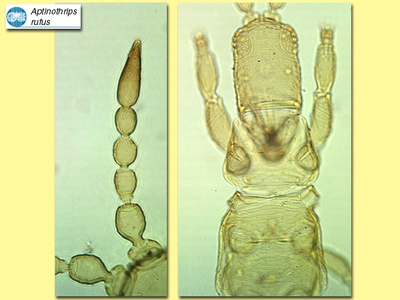Figures
Fig. 1 Antenna, head and thorax
Fig. 2 Sternite VII (male)
Fig. 3 Tergite VIII
Fig. 4 Tergite IX (male)
Species
Aptinothrips rufus Haliday
Biology
Adults and larvae can be found on a wide range of grass species.
Distribution
Found throughout the temperate areas of the world, including mountains in tropical countries, but presumably originally from Europe and widely distributed in hay and straw.
Recognition
Small, slender apterous thrips. Antennae 6-segmented, segment VI large resulting from fusion of 3 segments; III & IV with sense cone simple. Head elongate with vertex weakly reticulate. Pronotum with no long setae. Tergites and sternites weakly reticulate, with a transverse row of discal setae. Tarsi 1-segmented.
Related species
There are four species in this genus, all from grasses, but the only other common species, A. stylifer, has 8-segmented antennae with a 2-segmented terminal style, and 2-segmented tarsi.





